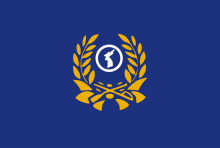Republic of Korea Reserve Forces
The Republic of Korea Reserve Forces (ROKRF; Korean: 대한민국 예비군; Hanja: 大韓民國 豫備軍, Daehanminguk Yebigun), also known as the ROK Reserve Forces, is the 3,100,000[3] reserve force of South Korea.
| Republic of Korea Reserve Forces | |
|---|---|
| 대한민국 예비군 동원예비군 Dongwon Yebigun | |
 Flag | |
| Country | |
| Allegiance | The Korean race (until April 2011)[1][2] |
| Nickname(s) | "Yebigun" |
There are two major branches of the Reserve Forces: the Mobilization Reserve Forces (Korean: 동원예비군, Hanja: 動員豫備軍; Dongwon Yebigun) and the Homeland Reserve Forces (Korean: 향토예비군, hanja: 鄕土豫備軍; Hyangto Yebigun), a Home Guard type force. Soldiers who have completed their service in the Republic of Korea Armed Forces are automatically transferred to the Reserve Forces and must first serve 4 years in the Mobilization Reserve and then 4 years as an Homeland Reservist. During wartime, about 5 divisions would be formed under the Mobilization Reserves, and deployed to the war zone to provide support and regional stabilization. In the meantime, the Homeland Reserve would defend the homeland from any possible attacks from the enemy.
History
The Homeland Reserve Force was established in April 1968 as part of a nationwide program to increase emergency defense capabilities in response to increased North Korean infiltration. In January 1968, a North Korean commando unit infiltrated Seoul and attacked the Blue House Presidential residence in an attempt to assassinate South Korean President Park Chung Hee. That same month, two additional North Korean commando units launched attacks on towns on the Korean east coast in attempts to create an insurgency.
Civil Defense
In 1980 there were over 90,000 civil defense personnel in the country. By 1990 there were more than 3.5 million civil defense personnel in reserve. Their missions included air raid defense, search and rescue missions, building and road repair.
Equipment
Small Arms
- Daewoo K2
- Colt M16A1
- M1 Carbine
- M1 Garand
References
- "New Pledge of Allegiance to Reflect Growing Multiculturalism". The Chosun Ilbo. South Korea. 18 April 2011. Archived from the original on April 20, 2011. Retrieved 20 April 2011.
The military has decided to omit the word 'minjok,' which refers to the Korean race, from the oath of enlistment for officers and soldiers, and replace it with 'the citizen.' The measure reflects the growing number of foreigners who gain Korean citizenship and of children from mixed marriages entering military service.
- Doolan, Yuri W. (June 2012). "Being Amerasian in South Korea: Purebloodness, Multiculturalism, and Living Alongside the U.S. Military Empire". The Ohio State University: 63. hdl:1811/52015. Cite journal requires
|journal=(help) - "2018 Defence White Paper" (PDF). December 2018.
External links
- Homeland Reserve Forces official website (In Korean)
- Globalsecurity on Homeland Reserve Forces
- Federation of American Scientists on HRF